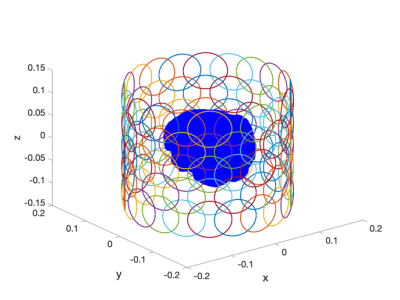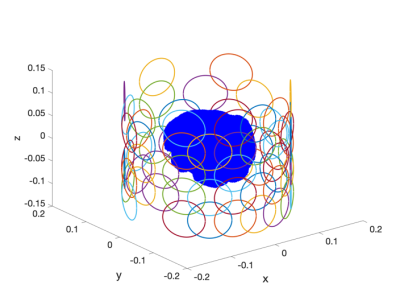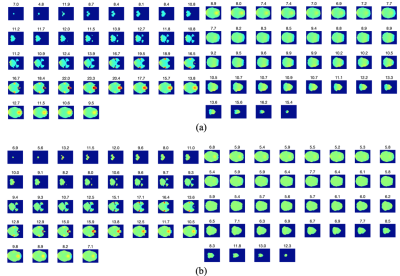4229
Optimization of Multi-Coil Array Design for Efficient Human Brain Shimming at 3T
Yubin Cai1, Hsin-Jung Yang1, Xinqi Li2, Tianshi Hu2, Yuheng Huang2, Yujie Shan2, Meng Lu1, Wai Shing Liu2, Debiao Li1, and Hui Han1
1Biomedical Imaging Research Institute, Cedars-Sinai Medical Center, Los Angeles, CA, United States, 2Cedars-Sinai Medical Center, Los Angeles, CA, United States
1Biomedical Imaging Research Institute, Cedars-Sinai Medical Center, Los Angeles, CA, United States, 2Cedars-Sinai Medical Center, Los Angeles, CA, United States
Synopsis
Introduction
There have been a considerable amount of work conducted to design multi-coil arrays (MCA) for human brain shimming at 3T1-7. Menese, et al. has proposed a numerical method to find optimal geometry and positions of shimming coils, although they are difficult to be implemented8. In this work, we proposed an optimization algorithm to identify the redundancy in a surface shimming coil system. The algorithm utilized mathematical models, such as singular value decomposition (SVD) and principle component analysis (PCA) to derive the importance of each surface shimming coils in a realistic shimming environment. We tested the algorithm using a set of evenly distributed surface shimming coils with a cylindrical coverage. Brain field maps from the Human Connectome Project (HCP) were used to test the efficacy of the algorithm. We successfully demonstrated that 95% of the shimming capability can be preserved with 30% reduction in shimming channels using the proposed algorithm.Methods
Field maps of human heads (N=500) from the HCP were used for the optimization process. 100 surface shimming coils were placed around the targeted field-of-view in a cylindrical fashion. The corresponding shim field of each coil was derived using Biot-Savart Law. After proper alignment and masking of the HCP field maps, the field maps were decomposed using a SVD model to identify the key elements in human brain field variation. To further identify the efficacy of each surface shimming coils and reduce system redundancy, the shim field were derived using a least square mean regression model for each key element using the surface shimming coils. Consequently, a PCA analysis were performed iteratively to identify the key components from the cylindrical shimming system, which helps decide the contribution of each coil to the shimming field matrix. By ranking the contributions, the redundant coil can be identified and removed. A worth noting component in the algorithm is to determine if the convergence condition is satisfied. If not, the algorithm loops back to the current solving step for the set of newly truncated multi-coil array. This iterative process essentially ensures that we carefully remove the least contributing coils and leverage the dynamics among the coils’ radiated fields by exploring different current compositions.Results
Fig. 1 shows the 3-dimensional view of the initial single-layer 100 4-cm-radius circular coils around a 0.15-m-radius cylinder. 34 redundant coils are being removed from the algorithm, plotted in Fig. 2. A comparison, shown in Fig.3, is regarding the 72 slices of the human brain field maps before and after the shimming of the truncated multi-coil array. Whole brain shimming is applied to both cases with 100 coils before truncation and 66 coils after truncation. Then the standard deviation of frequencies across the whole brain was compared between before and after shimming. As shown in Fig. 4, the shimming performance remains almost the same when 100 coils are being reduced to 66 coils.Discussion and Conclusion
The numerical results have proven that the proposed algorithm has successfully identified and removed redundant coils. The final 66-channel multi-coil array has demonstrated to maintain a shimming performance comparable to that for the original 100 coils. It suggests a significant number of coils is essentially redundant. Also the reserved coils are nearly symmetric with respect to the central plane and the results agree with the intuition that the coils farther away from the isocenter are less critical than the ones closer. Further works on this topic include 1) considering the variations in subject location and motions 2) adding shim coil geometry, and placement into the optimization routine and algorithm architecture, and 3) using the Eigen brains generated from the dataset instead of raw data to obtain a more generalized results.Acknowledgements
No acknowledgement found.References
- Juchem C., Nixon T. W., McIntyre S.et al.J Magn Reson.2010;204:281-289.
- Juchem C., Green D. & de Graaf R. A.J Magn Reson.2013;236:95-104.
- Juchem C. & de Graaf R. A.Magn Reson Med.2017;78:2042-2047.
- Hui Han, Allen W Song, and Trong-Kha Truong. Integrated parallel reception, excitation, and shimming(ipres). Magnetic resonance in medicine, 70(1):241–247, 2013.
- Truong TK, Darnell D, and Song AW. Integrated RF/shim coil array for parallel reception and localized B0 shimming in the human brain. NeuroImage 2014;103:235–240.
- Stockmann JP, Witzel T, Keil B, et al. A 32-channel combined RF and B0 shim array for 3T brain imaging. Magn Reson Med 2016;75:441-451.
- Han Hui, John Stager, Hsin-Jung Yang, Na Zhang, Sizhe Guo, Zhuoqi Li, Yicheng Wang, and Debiao Lil. Unified coils (unic) for simultaneous RF reception and targeted local b0 shimming. ISMRM, (4338),2016.
-
B.P. Meneses, A. Amadon. Optimized multi-coil array design for human brain shimming at Ultra-High Field. ISMRM 2019
Figures

Fig. 1. The figure
shows the initial coil design with loops in a single layer. The radius of the
cylinder is 0.15m. All coil radius is 0.04m. And the brain matrix center is
(0,0,0).

Fig. 2. The figure shows
the results after the coil truncation. 34 redundant coils are removed.

Fig. 3.
72 slices
of the field maps respectively in (a) without (b) with shimming of the
truncated multi-coil array. The STD value is labeled on top of each figure.

Fig. 4.
X-axis
means the number of reserved coils after reduction from 100 coils. Y-axis represents
the shimming performance, which is quantified as the ratio between the std.
dev. of frequency offsets across the whole brain after shimming versus that
before shimming. The shimming performance remains almost the same for 100 coils
being reduced to 66 coils.